Enhanced Photovoltaic Performance of Inverted Perovskite Solar Cells through Surface Modification of a NiOx-Based Hole-Transporting Layer with Quaternary Ammonium Halide–Containing Cellulose Derivatives
Abstract
1. Introduction
2. Experimental Details
2.1. Chemicals
2.2. Characterization of Cellulose Derivatives and Perovskite Layers
2.3. Fabrication and Characterization of PVSCs
3. Results and Discussion
3.1. Characterization of Cellulose Derivative–Modified NiOx Layers
3.2. Morphologies of Perovskite Films Deposited on Cellulose Derivative–Modified NiOx Layers
3.3. XRD Images of Perovskite Films Deposited on Cellulose Derivative–Modified NiOx Layers
3.4. UV–Vis Absorption Spectra of MAPbI3 Films Deposited on Cellulose Derivative–Modified NiOx Layers
3.5. PV Properties of PVSCs Incorporating Cellulose Derivative–Modified NiOx Layers
4. Conclusions
Supplementary Materials
Author Contributions
Funding
Institutional Review Board Statement
Informed Consent Statement
Data Availability Statement
Acknowledgments
Conflicts of Interest
References
- Kojima, A.; Teshima, K.; Shirai, Y.; Miyasaka, T. Organometal halide perovskite as visible-light sensitizers for photovoltaic cells. J. Am. Chem. Soc. 2009, 131, 6050–6051. [Google Scholar] [CrossRef] [PubMed]
- Yu, Z.; Chen, B.; Liu, P.; Wang, C.; Bu, C.; Cheng, N.; Bai, S.; Yan, Y.; Zhao, X. Stable organic–inorganic perovskite solar cells without hole-conductor layer achieved via cell structure design and contact engineering. Adv. Funct. Mater. 2016, 26, 4866–4873. [Google Scholar] [CrossRef]
- Kumar, N.S.; Naidu, K.C.B. A review on perovskite solar cells (PSCs), materials and applications. J. Materiomics 2021, 7, 940–956. [Google Scholar] [CrossRef]
- Schmidt-Mende, L.; Dyakonov, V.; Olthof, S.; Ünlü, F.; Lê, K.M.T.; Mathur, S.; Karabanov, A.D.; Lupascu, D.C.; Herz, L.M.; Hinderhofer, A. Roadmap on organic–inorganic hybrid perovskite semiconductors and devices. APL Mater. 2021, 9, 109202. [Google Scholar] [CrossRef]
- Lee, M.M.; Teuscher, J.; Miyasaka, T.; Murakami, T.N.; Snaith, H.J. Efficient hybrid solar cells based on meso-superstructured organometal halide perovskites. Science 2012, 338, 643–647. [Google Scholar] [CrossRef]
- Zhang, W.; Saliba, M.; Stranks, S.D.; Sun, Y.; Shi, X.; Wiesner, U.; Snaith, H.J. Enhancement of perovskite-based solar cells employing core–shell metal nanoparticles. Nano Lett. 2013, 13, 4505–4510. [Google Scholar] [CrossRef]
- Jeon, N.J.; Noh, J.H.; Kim, Y.C.; Yang, W.S.; Ryu, S.; Seok, S.I. Solvent engineering for high-performance inorganic–organic hybrid perovskite solar cells. Nat. Mater. 2014, 13, 897–903. [Google Scholar] [CrossRef]
- Baikie, T.; Fang, Y.; Kadro, J.M.; Schreyer, M.; Wei, F.; Mhaisalkar, S.G.; Graetzel, M.; White, T.J. Synthesis and crystal chemistry of the hybrid perovskite (CH3NH3)PbI3 for solid-state sensitised solar cell applications. J. Mater. Chem. A 2013, 1, 5628–5641. [Google Scholar] [CrossRef]
- Ahn, N.; Son, D.-Y.; Jang, I.-H.; Kang, S.M.; Choi, M.; Park, N.-G. Highly reproducible perovskite solar cells with average efficiency of 18.3% and best efficiency of 19.7% fabricated via Lewis base adduct of lead (II) iodide. J. Am. Chem. Soc. 2015, 137, 8696–8699. [Google Scholar] [CrossRef]
- Homola, T.S.; Pospisil, J.; Shekargoftar, M.; Svoboda, T.s.; Hvojnik, M.; Gemeiner, P.; Weiter, M.; Dzik, P. Perovskite solar cells with low-cost TiO2 mesoporous photoanodes prepared by rapid low-temperature (70° C) plasma processing. ACS Appl. Energy Mater. 2020, 3, 12009–12018. [Google Scholar] [CrossRef]
- Kim, G.W.; Kang, G.; Kim, J.; Lee, G.Y.; Kim, H.I.; Pyeon, L.; Lee, J.; Park, Y. Dopant-free polymeric hole transport materials for highly efficient and stable perovskite solar cells. Energy Environ. Sci. 2016, 9, 2326–2333. [Google Scholar] [CrossRef]
- Kranthiraja, K.; Park, S.H.; Kim, H.; Gunasekar, K.; Han, G.; Kim, B.J.; Kim, C.S.; Kim, S.; Lee, H.; Nishikubo, R.; et al. Accomplishment of multifunctional π-conjugated polymers by regulating the degree of side-chain fluorination for efficient dopant-free ambient-stable perovskite solar cells and organic solar cells. ACS Appl. Mater. Interfaces 2017, 9, 36053–36060. [Google Scholar] [CrossRef]
- Kranthirajaa, K.; Arivunithia, V.M.; Aryala, U.K.; Parka, H.Y.; Choa, W.; Kima, J.; Reddya, S.S.; Kimb, H.K.; Kangc, I.N.; Songd, M.; et al. Efficient and hysteresis-less perovskite and organic solar cells by employing donor-acceptor type π-conjugated polymer. Org. Electron. 2019, 72, 18–24. [Google Scholar] [CrossRef]
- Yang, W.S.; Park, B.-W.; Jung, E.H.; Jeon, N.J.; Kim, Y.C.; Lee, D.U.; Shin, S.S.; Seo, J.; Kim, E.K.; Noh, J.H. Iodide management in formamidinium-lead-halide–based perovskite layers for efficient solar cells. Science 2017, 356, 1376–1379. [Google Scholar] [CrossRef] [PubMed]
- Leijtens, T.; Eperon, G.E.; Pathak, S.; Abate, A.; Lee, M.M.; Snaith, H.J. Overcoming ultraviolet light instability of sensitized TiO2 with meso-superstructured organometal tri-halide perovskite solar cells. Nat. Commun. 2013, 4, 1–8. [Google Scholar] [CrossRef] [PubMed]
- Ke, W.; Fang, G.; Liu, Q.; Xiong, L.; Qin, P.; Tao, H.; Wang, J.; Lei, H.; Li, B.; Wan, J. Low-temperature solution-processed tin oxide as an alternative electron transporting layer for efficient perovskite solar cells. J. Am. Chem. Soc. 2015, 137, 6730–6733. [Google Scholar] [CrossRef]
- Lin, X.; Cui, D.; Luo, X.; Zhang, C.; Han, Q.; Wang, Y.; Han, L. Efficiency progress of inverted perovskite solar cells. Energy Environ. Sci. 2020, 13, 3823–3847. [Google Scholar] [CrossRef]
- Degani, M.; An, Q.; Albaladejo-Siguan, M.; Hofstetter, Y.J.; Cho, C.; Paulus, F.; Grancini, G.; Vaynzof, Y. 23.7% Efficient inverted perovskite solar cells by dual interfacial modification. Sci. Adv. 2021, 7, eabj7930. [Google Scholar] [CrossRef]
- Li, S.; He, B.; Xu, J.; Lu, H.; Jiang, J.; Zhu, J.; Kan, Z.; Zhu, L.; Wu, F. Highly efficient inverted perovskite solar cells incorporating P3CT-Rb as a hole transport layer to achieve a large open circuit voltage of 1.144 V. Nanoscale 2020, 12, 3686–3691. [Google Scholar] [CrossRef]
- Wu, F.; Xiao, Q.; Sun, X.; Wu, T.; Hua, Y.; Zhu, L. Hole transporting layer engineering via a zwitterionic polysquaraine toward efficient inverted perovskite solar cells. Chem. Eng. J. 2022, 445, 136760. [Google Scholar] [CrossRef]
- Li, S.; Lu, H.; Kan, Z.; Zhu, L.; Wu, F. Engineering of P3CT-Na through diprophylline treatment to realize efficient and stable inverted perovskite solar cells. Chem. Eng. J. 2021, 419, 129581. [Google Scholar] [CrossRef]
- Seo, Y.-H.; Cho, I.H.; Na, S.-I. Investigation of sol-gel and nanoparticle-based NiOx hole transporting layer for high-performance planar perovskite solar cells. J. Alloys Compd. 2019, 797, 1018–1024. [Google Scholar] [CrossRef]
- Liu, G.Z.; Du, C.S.; Wu, J.Y.; Liu, B.T.; Wu, T.M.; Huang, C.-F.; Lee, R.H. Enhanced photovoltaic properties of perovskite solar cells by employing bathocuproine/hydrophobic polymer films as hole-blocking/electron-transporting interfacial layers. Polymers 2020, 13, 42. [Google Scholar] [CrossRef]
- Kuo, D.W.; Liu, G.Z.; Lee, R.H. Star-shaped molecule with planar triazine core and perylene diimide branches as an n-type additive for bulk-heterojunction perovskite solar cells. Dyes Pigm. 2019, 170, 107562. [Google Scholar] [CrossRef]
- Chu, H.Y.; Hong, J.Y.; Huang, C.F.; Wu, J.Y.; Wang, T.L.; Wu, T.M.; Lee, R.H. Enhanced photovoltaic properties of perovskite solar cells by the addition of cellulose derivatives to MAPbI3 based photoactive layer. Cellulose 2019, 26, 9229–9239. [Google Scholar] [CrossRef]
- Zhang, S.; Stolterfoht, M.; Armin, A.; Lin, Q.; Zu, F.; Sobus, J.; Jin, H.; Koch, N.; Meredith, P.; Burn, P.L. Interface engineering of solution-processed hybrid organohalide perovskite solar cells. ACS Appl. Mater. Interfaces 2018, 10, 21681–21687. [Google Scholar] [CrossRef]
- He, M.; Li, B.; Cui, X.; Jiang, B.; He, Y.; Chen, Y.; O’Neil, D.; Szymanski, P.; Ei-Sayed, M.A.; Huang, J. Meniscus-assisted solution printing of large-grained perovskite films for high-efficiency solar cells. Nat. Commun. 2017, 8, 1–10. [Google Scholar] [CrossRef]
- Kim, Y.; Jung, E.H.; Kim, G.; Kim, D.; Kim, B.J.; Seo, J. Sequentially fluorinated PTAA polymers for enhancing VOC of high-performance perovskite solar cells. Adv. Energy Mater. 2018, 8, 1801668. [Google Scholar] [CrossRef]
- Yang, J.; Tang, W.; Yuan, R.; Chen, Y.; Wang, J.; Wu, Y.; Yin, W.J.; Yuan, N.; Ding, J.; Zhang, W.-H. Defect mitigation using d-penicillamine for efficient methylammonium-free perovskite solar cells with high operational stability. Chem. Sci. 2021, 12, 2050–2059. [Google Scholar] [CrossRef]
- Liao, Q.; Wang, Y.; Yao, X.; Su, M.; Li, B.; Sun, H.; Huang, J.; Guo, X. A dual-functional conjugated polymer as an efficient hole-transporting layer for high-performance inverted perovskite solar cells. ACS Appl. Mater. Interfaces 2021, 13, 16744–16753. [Google Scholar] [CrossRef]
- Wang, B.; Wu, F.; Bi, S.; Zhou, J.; Wang, J.; Leng, X.; Zhang, D.; Meng, R.; Xue, B.; Zong, C. A polyaspartic acid sodium interfacial layer enhances surface trap passivation in perovskite solar cells. J. Mater. Chem. A 2019, 7, 23895–23903. [Google Scholar] [CrossRef]
- Lim, K.G.; Kim, H.B.; Jeong, J.; Kim, H.; Kim, J.Y.; Lee, T.W. Boosting the power conversion efficiency of perovskite solar cells using self-organized polymeric hole extraction layers with high work function. Adv. Mater. 2014, 26, 6461–6466. [Google Scholar] [CrossRef] [PubMed]
- Liu, T.; Chen, K.; Hu, Q.; Zhu, R.; Gong, Q. Inverted perovskite solar cells: Progresses and perspectives. Adv. Energy Mater. 2016, 6, 1600457. [Google Scholar] [CrossRef]
- Li, E.; Guo, Y.; Liu, T.; Hu, W.; Wang, N.; He, H.; Lin, H. Preheating-assisted deposition of solution-processed perovskite layer for an efficiency-improved inverted planar composite heterojunction solar cell. RSC Adv. 2016, 6, 30978–30985. [Google Scholar] [CrossRef]
- Nkele, A.C.; Nwanya, A.C.; Shinde, N.M.; Ezugwu, S.; Maaza, M.; Shaikh, J.S.; Ezema, F.I. The use of nickel oxide as a hole transport material in perovskite solar cell configuration: Achieving a high performance and stable device. Int. J. Energy Res. 2020, 44, 9839–9863. [Google Scholar] [CrossRef]
- Jin, Z.; Guo, Y.; Yuan, S.; Zhao, J.-S.; Liang, X.-M.; Qin, Y.; Zhang, J.-P.; Ai, X.-C. Modification of NiO x hole transport layer for acceleration of charge extraction in inverted perovskite solar cells. RSC Adv. 2020, 10, 12289–12296. [Google Scholar] [CrossRef]
- Liu, J.; Yin, X.; Guo, Y.; Que, M.; Chen, J.; Chen, Z.; Que, W. Influence of hole transport layers/perovskite interfaces on the hysteresis behavior of inverted perovskite solar cells. ACS Appl. Energy Mater. 2020, 3, 6391–6399. [Google Scholar] [CrossRef]
- Liu, Z.; Chang, J.; Lin, Z.; Zhou, L.; Yang, Z.; Chen, D.; Zhang, C.; Liu, S.; Hao, Y. High performance planar perovskite solar cells using low temperature, solution–combustion-based nickel oxide hole transporting layer with efficiency exceeding 20%. Adv. Energy Mater. 2018, 8, 1703432. [Google Scholar] [CrossRef]
- Yin, X.; Yao, Z.; Luo, Q.; Dai, X.; Zhou, Y.; Zhang, Y.; Zhou, Y.; Luo, S.; Li, J.; Wang, N. High efficiency inverted planar perovskite solar cells with solution-processed NiO x hole contact. ACS Appl. Mater. Interfaces 2017, 9, 2439–2448. [Google Scholar] [CrossRef]
- Yue, S.; Liu, K.; Xu, R.; Li, M.; Azam, M.; Ren, K.; Liu, J.; Sun, Y.; Wang, Z.; Cao, D. Efficacious engineering on charge extraction for realizing highly efficient perovskite solar cells. Energy Environ. Sci. 2017, 10, 2570–2578. [Google Scholar] [CrossRef]
- Yin, X.; Que, M.; Xing, Y.; Que, W. High efficiency hysteresis-less inverted planar heterojunction perovskite solar cells with a solution-derived NiO x hole contact layer. J. Mater. Chem. A 2015, 3, 24495–24503. [Google Scholar] [CrossRef]
- Choi, F.P.G.; Alishah, H.M.; Bozar, S.; Kahveci, C.; Rodop, M.C.; Gunes, S. First demonstration of lithium, cobalt and magnesium introduced nickel oxide hole transporters for inverted methylammonium lead triiodide based perovskite solar cells. Sol Energy 2021, 215, 434–442. [Google Scholar] [CrossRef]
- Kim, J.K.; Nguyen, D.N.; Lee, J.H.; Kang, S.; Kim, Y.; Kim, S.S.; Kim, H.K. Carbon quantum dot-incorporated nickel oxide for planar pin type perovskite solar cells with enhanced efficiency and stability. J. Alloys Compd. 2020, 818, 152887. [Google Scholar] [CrossRef]
- Guo, Y.; Jin, Z.; Yuan, S.; Zhao, J.S.; Hao, M.Y.; Qin, Y.; Fu, L.M.; Zhang, J.P.; Ai, X.C. Effects of interfacial energy level alignment on carrier dynamics and photovoltaic performance of inverted perovskite solar cells. J. Power Sources 2020, 452, 227845. [Google Scholar] [CrossRef]
- Shen, G.; Cai, Q.; Dong, H.; Wen, X.; Xu, X.; Mu, C. Using interfacial contact engineering to solve nickel oxide/perovskite interface contact issues in inverted perovskite solar cells. ACS Sustain. Chem. Eng. 2021, 9, 3580–3589. [Google Scholar] [CrossRef]
- Wang, H.; Huang, Z.; Xiao, S.; Meng, X.; Xing, Z.; Rao, L.; Gong, C.; Wu, R.; Hu, T.; Tan, L. An in situ bifacial passivation strategy for flexible perovskite solar module with mechanical robustness by roll-to-roll fabrication. J. Mater. Chem. A 2021, 9, 5759–5768. [Google Scholar] [CrossRef]
- Zhang, B.; Su, J.; Guo, X.; Zhou, L.; Lin, Z.; Feng, L.; Zhang, J.; Chang, J.; Hao, Y. NiO/perovskite heterojunction contact engineering for highly efficient and stable perovskite solar cells. Adv. Sci. 2020, 7, 1903044. [Google Scholar] [CrossRef] [PubMed]
- Chen, M.; Qiao, H.W.; Zhou, Z.; Ge, B.; He, J.; Yang, S.; Hou, Y.; Yang, H.G. Homogeneous doping of entire perovskite solar cells via alkali cation diffusion from the hole transport layer. J. Mater. Chem. A 2021, 9, 9266–9271. [Google Scholar] [CrossRef]
- Liu, B.-T.; Lin, H.-R.; Lee, R.-H.; Gorji, N.E.; Chou, J.-C. Fabrication and characterization of an efficient inverted perovskite solar cells with POSS passivating hole transport layer. Nanomaterials 2021, 11, 974. [Google Scholar] [CrossRef]
- Xie, L.; Cao, Z.; Wang, J.; Wang, A.; Wang, S.; Cui, Y.; Xiang, Y.; Niu, X.; Hao, F.; Ding, L. Improving energy level alignment by adenine for efficient and stable perovskite solar cells. Nano Energy 2020, 74, 104846. [Google Scholar] [CrossRef]
- Kim, B.G.; Jang, W.; Park, Y.J.; Kang, J.H.; Seo, J.H.; Wang, D.H. Chelating Agent Mediated Sol–Gel Synthesis for Efficient Hole Extracted Perovskite Photovoltaics. J. Phys. Chem. C 2020, 124, 25184–25195. [Google Scholar] [CrossRef]
- Feng, X.; Wang, S.; Guo, Q.; Zhu, Y.; Xiu, J.; Huang, L.; Tang, Z.; He, Z. Dialkylamines driven two-step recovery of NiO x/ITO substrates for high-reproducibility recycling of perovskite solar cells. J. Phys. Chem. Lett. 2021, 12, 4735–4741. [Google Scholar] [CrossRef] [PubMed]
- Mann, D.S.; Patil, P.; Kwon, S.-N.; Na, S.I. Enhanced performance of pin perovskite solar cell via defect passivation of nickel oxide/perovskite interface with self-assembled monolayer. Appl. Surf. Sci. 2021, 560, 149973. [Google Scholar] [CrossRef]
- Cheng, H.; Li, Y.; Zhao, G.; Zhao, K.; Wang, Z.S. Pyridine-terminated conjugated organic molecules as an interfacial hole transfer bridge for NiO x-based perovskite solar cells. ACS Appl. Mater. Interfaces 2019, 11, 28960–28967. [Google Scholar] [CrossRef] [PubMed]
- Mangalam, J.; Rath, T.; Weber, S.; Kunert, B.; Dimopoulos, T.; Fian, A.; Trimmel, G. Modification of NiOx hole transport layers with 4-bromobenzylphosphonic acid and its influence on the performance of lead halide perovskite solar cells. J. Mater. Sci. Mater. Electron. 2019, 30, 9602–9611. [Google Scholar] [CrossRef]
- Zhao, S.; Zhuang, J.; Liu, X.; Zhang, H.; Zheng, R.; Peng, X.; Gong, X.; Guo, H.; Wang, H.; Li, H. F4-TCNQ doped strategy of nickel oxide as high-efficient hole transporting materials for invert perovskite solar cell. Mater. Sci. Semicond. Process. 2021, 121, 105458. [Google Scholar] [CrossRef]
- Maddala, S.; Chung, C.L.; Wang, S.Y.; Kollimalayan, K.; Hsu, H.L.; Venkatakrishnan, P.; Chen, C.P.; Chang, Y.J. Forming a metal-free oxidatively coupled agent, bicarbazole, as a defect passivation for htm and an interfacial layer in ap–i–n perovskite solar cell exhibits nearly 20% efficiency. Chem. Mater. 2019, 32, 127–138. [Google Scholar] [CrossRef]
- Lee, S.; Lee, J.; Park, H.; Choi, J.; Baac, H.W.; Park, S.; Park, H.J. Defect-passivating organic/inorganic bicomponent hole-transport layer for high efficiency metal-halide perovskite device. ACS Appl. Mater. Interfaces 2020, 12, 40310–40317. [Google Scholar] [CrossRef]
- Chang, Y.M.; Li, C.W.; Lu, Y.-L.; Wu, M.S.; Li, H.; Lin, Y.S.; Lu, C.-W.; Chen, C.P.; Chang, Y.J. Spherical hole-transporting interfacial layer passivated defect for inverted NiO x-based planar perovskite solar cells with high efficiency of over 20%. ACS Appl. Mater. Interfaces 2021, 13, 6450–6460. [Google Scholar] [CrossRef]
- Chen, Y.C.; Li, Y.H.; Chung, C.L.; Hsu, H.L.; Chen, C.P. Triphenylamine dibenzofulvene–derived dopant-free hole transporting layer induces micrometer-sized perovskite grains for highly efficient near 20% for p-i-n perovskite solar cells. Prog Photovolt 2020, 28, 49–59. [Google Scholar] [CrossRef]
- Park, B.; Aggarwal, Y.; Bae, I.G.; Park, J.; Choi, E.H. Simple and efficient perovskite solar cells with multi-functional mixed interfacial layers. Adv. Mater. Interfaces 2021, 8, 2002007. [Google Scholar] [CrossRef]
- Wang, C.; Yang, H.; Xia, X.; Wang, X.; Li, F. Suppressing interfacial defect formation derived from in-situ-generated polyethylenimine-based 2D perovskites to boost the efficiency and stability NiOx-based inverted planar perovskite solar cells. Appl. Surf. Sci. 2021, 548, 149276. [Google Scholar] [CrossRef]
- Hsiao, K.C.; Lee, B.T.; Jao, M.H.; Lin, T.H.; Hou, C.H.; Shyue, J.J.; Wu, M.C.; Su, W.F. Chloride gradient render carrier extraction of hole transport layer for high Voc and efficient inverted organometal halide perovskite solar cell. Chem. Eng. J. 2021, 409, 128100. [Google Scholar] [CrossRef]
- Hu, T.; Zhang, F.; Yu, H.; Zhang, M.; Yu, Y.; Zhang, W.; Liu, R.; Tian, L.; Ma, Z. Efficient carrier transport via dual-function interfacial engineering using cesium iodide for high-performance perovskite solar cells based on NiOx hole transporting materials. Nano Res. 2021, 14, 3864–3872. [Google Scholar] [CrossRef]
- Sadegh, F.; Akin, S.; Moghadam, M.; Keshavarzi, R.; Mirkhani, V.; Ruiz-Preciado, M.A.; Akman, E.; Zhang, H.; Amini, M.; Tangestaninejad, S. Copolymer-templated nickel oxide for high-efficiency mesoscopic perovskite solar cells in inverted architecture. Adv. Funct. Mater. 2021, 31, 2102237. [Google Scholar] [CrossRef]
- Yang, J.; Xiong, S.; Qu, T.; Zhang, Y.; He, X.; Guo, X.; Zhao, Q.; Braun, S.; Chen, J.; Xu, J. Extremely low-cost and green cellulose passivating perovskites for stable and high-performance solar cells. ACS Appl. Mater. Interfaces 2019, 11, 13491–13498. [Google Scholar] [CrossRef]
- He, J.; Ng, C.F.; Young Wong, K.; Liu, W.; Chen, T. Photostability and moisture stability of CH3NH3PbI3-based solar cells by ethyl cellulose. ChemPlusChem 2016, 81, 1292–1298. [Google Scholar] [CrossRef]
- Zhang, P.; Gu, N.; Song, L.; Chen, W.H.; Du, P.; Yin, X.; Xiong, J. Bifunctional green cellulose derivatives employed for high efficiency and stable perovskite solar cells under ambient environment. J. Alloys Compd. 2021, 886, 161247. [Google Scholar] [CrossRef]
- Bisconti, F.; Giuri, A.; Dominici, L.; Carallo, S.; Quadrivi, E.; Biagini, P.; Listorti, A.; Corcione, C.E.; Colella, S.; Rizzo, A. Managing transparency through polymer/perovskite blending: A route toward thermostable and highly efficient, semi-transparent solar cells. Nano Energy 2021, 89, 106406. [Google Scholar] [CrossRef]
- Du, C.S.; Ho, I.H.; Huang, Y.J.; Lee, R.H. Quaternary ammonium halide-containing cellulose derivatives for defect passivation in MAPbI3-based perovskite solar cells. Sustain. Energy Fuels 2022, 6, 3349–3362. [Google Scholar] [CrossRef]
- Liu, Y.; Duan, J.; Zhang, J.; Huang, S.; Ou-Yang, W.; Bao, Q.; Sun, Z.; Chen, X. High efficiency and stability of inverted perovskite solar cells using phenethyl ammonium iodide-modified interface of NiOx and perovskite layers. ACS Appl. Mater. Interfaces 2019, 12, 771–779. [Google Scholar] [CrossRef] [PubMed]
- Zhang, S.; Yan, X.; Liu, Z.; Zhu, H.; Yang, Z.; Huang, Y.; Liu, S.; Wu, D.; Pan, M.; Chen, W. Evaporated potassium chloride for double-sided interfacial passivation in inverted planar perovskite solar cells. J. Energy Chem. 2021, 54, 493–500. [Google Scholar] [CrossRef]
- Ye, X.; Cai, H.; Su, J.; Yang, J.; Ni, J.; Li, J.; Zhang, J. Preparation of hysteresis-free flexible perovskite solar cells via interfacial modification. J. Mater. Sci. Technol. 2021, 61, 213–220. [Google Scholar] [CrossRef]
- Chen, Q.; Zhou, H.; Fang, Y.; Stieg, A.Z.; Song, T.B.; Wang, H.H.; Xu, X.; Liu, Y.; Lu, S.; You, J. The optoelectronic role of chlorine in CH3NH3PbI3 (Cl)-based perovskite solar cells. Nat. Commun. 2015, 6, 1–9. [Google Scholar] [CrossRef] [PubMed]
- Stranks, S.D.; Eperon, G.E.; Grancini, G.; Menelaou, C.; Alcocer, M.J.; Leijtens, T.; Herz, L.M.; Petrozza, A.; Snaith, H.J. Electron-hole diffusion lengths exceeding 1 micrometer in an organometal trihalide perovskite absorber. Science 2013, 342, 341–344. [Google Scholar] [CrossRef] [PubMed]
- Cai, F.; Yan, Y.; Yao, J.; Wang, P.; Wang, H.; Gurney, R.S.; Liu, D.; Wang, T. Ionic additive engineering toward high-efficiency perovskite solar cells with reduced grain boundaries and trap density. Adv. Funct. Mater. 2018, 28, 1801985. [Google Scholar] [CrossRef]
- Chen, H.C.; Lan, J.M.; Hsu, H.L.; Li, C.W.; Shieh, T.S.; Wong, K.T.; Chen, C.P. Synergistic improvements in the performance and stability of inverted planar MAPbI3-based perovskite solar cells incorporating benzylammonium halide salt additives. Mater. Chem. Front. 2021, 5, 3378–3387. [Google Scholar] [CrossRef]
- Xia, J.; Liang, C.; Mei, S.; Gu, H.; He, B.; Zhang, Z.; Liu, T.; Wang, K.; Wang, S.; Chen, S. Deep surface passivation for efficient and hydrophobic perovskite solar cells. J. Mater. Chem. A 2021, 9, 2919–2927. [Google Scholar] [CrossRef]
- Zhang, Y.-W.; Cheng, P.-P.; Tan, W.-Y.; Min, Y. Balance the thickness, transparency and stability of semi-transparent perovskite solar cells by solvent engineering and using a bifunctional additive. Appl. Surf. Sci. 2021, 537, 147908. [Google Scholar] [CrossRef]
- Hörantner, M.T.; Zhang, W.; Saliba, M.; Wojciechowski, K.; Snaith, H. Templated microstructural growth of perovskite thin films via colloidal monolayer lithography. Energy Environ. Sci. 2015, 8, 2041–2047. [Google Scholar] [CrossRef]
- Xiao, M.; Huang, F.; Huang, W.; Dkhissi, Y.; Zhu, Y.; Etheridge, J.; Gray-Weale, A.; Bach, U.; Cheng, Y.B.; Spiccia, L. A fast deposition-crystallization procedure for highly efficient lead iodide perovskite thin-film solar cells. Angew. Chem. Int. Ed. 2014, 53, 9898–9903. [Google Scholar] [CrossRef] [PubMed]
- Song, Z.; Watthage, S.C.; Phillips, A.B.; Tompkins, B.L.; Ellingson, R.J.; Heben, M.J. Impact of processing temperature and composition on the formation of methylammonium lead iodide perovskites. Chem. Mater. 2015, 27, 4612–4619. [Google Scholar] [CrossRef]
- Xue, Q.; Hu, Z.; Sun, C.; Chen, Z.; Huang, F.; Yip, H.-L.; Cao, Y. Metallohalide perovskite–polymer composite film for hybrid planar heterojunction solar cells. RSC Adv. 2015, 5, 775–783. [Google Scholar] [CrossRef]
- Du, Y.; Wu, J.; Zhang, X.; Zhu, Q.; Zhang, M.; Liu, X.; Zou, Y.; Wang, S.; Sun, W. Surface passivation using pyridinium iodide for highly efficient planar perovskite solar cells. J. Energy Chem. 2021, 52, 84–91. [Google Scholar] [CrossRef]
- Esparza, D.; Sidhik, S.; López-Luke, T.; Rivas, J.M.; De la Rosa, E. Light-induced effects on crystal size and photo-stability of colloidal CsPbBr3 perovskite nanocrystals. Mater. Res. Express. 2019, 6, 045041. [Google Scholar] [CrossRef]
- Dubey, A.; Adhikari, N.; Mabrouk, S.; Wu, F.; Chen, K.; Yang, S.; Qiao, Q. A strategic review on processing routes towards highly efficient perovskite solar cells. J. Mater. Chem. A 2018, 6, 2406–2431. [Google Scholar] [CrossRef]
- Li, X.; Liu, X.; Wang, X.; Zhao, L.; Jiu, T.; Fang, J. Polyelectrolyte based hole-transporting materials for high performance solution processed planar perovskite solar cells. J. Mater. Chem. A 2015, 3, 15024–15029. [Google Scholar] [CrossRef]
- Sun, C.; Guo, Y.; Fang, B.; Yang, J.; Qin, B.; Duan, H.; Chen, Y.; Li, H.; Liu, H. Enhanced photovoltaic performance of perovskite solar cells using polymer P (VDF-TrFE) as a processed additive. J. Phys. Chem. C 2016, 120, 12980–12988. [Google Scholar] [CrossRef]
- Rose, A. Space-charge-limited currents in solids. Phys. Rev. 1955, 97, 1538. [Google Scholar] [CrossRef]
- Targhi, F.F.; Jalili, Y.S.; Kanjouri, F. MAPbI3 and FAPbI3 perovskites as solar cells: Case study on structural, electrical and optical properties. Results Phys. 2018, 10, 616–627. [Google Scholar] [CrossRef]
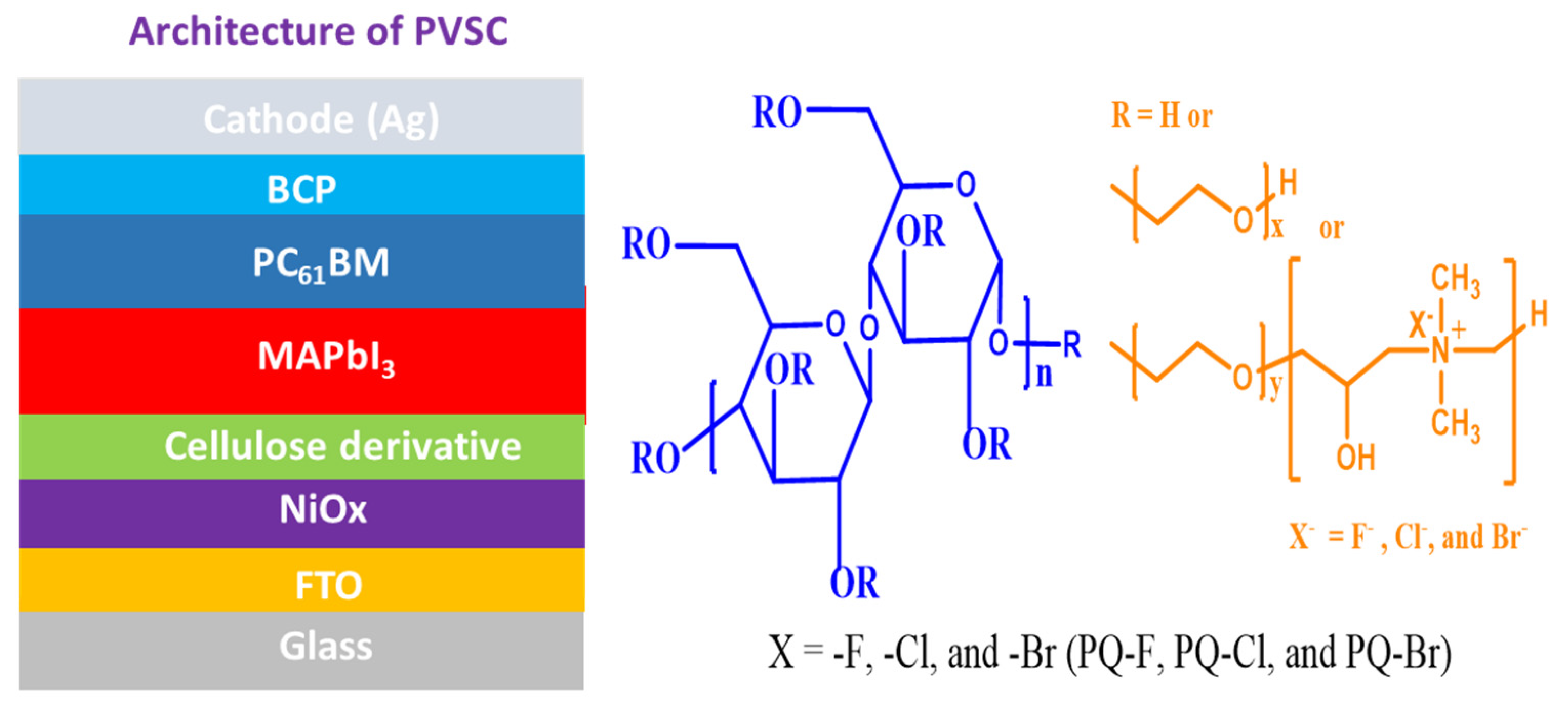
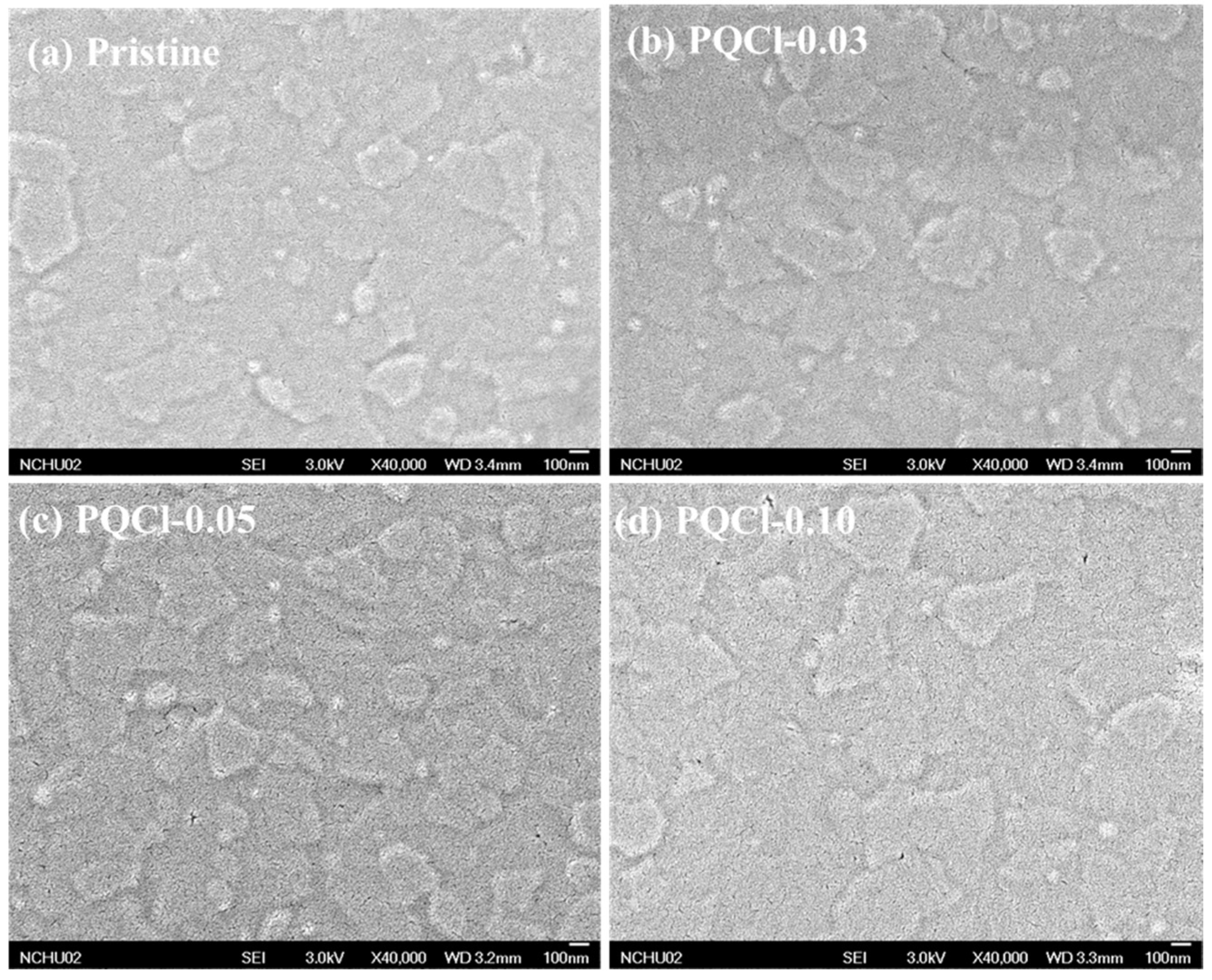
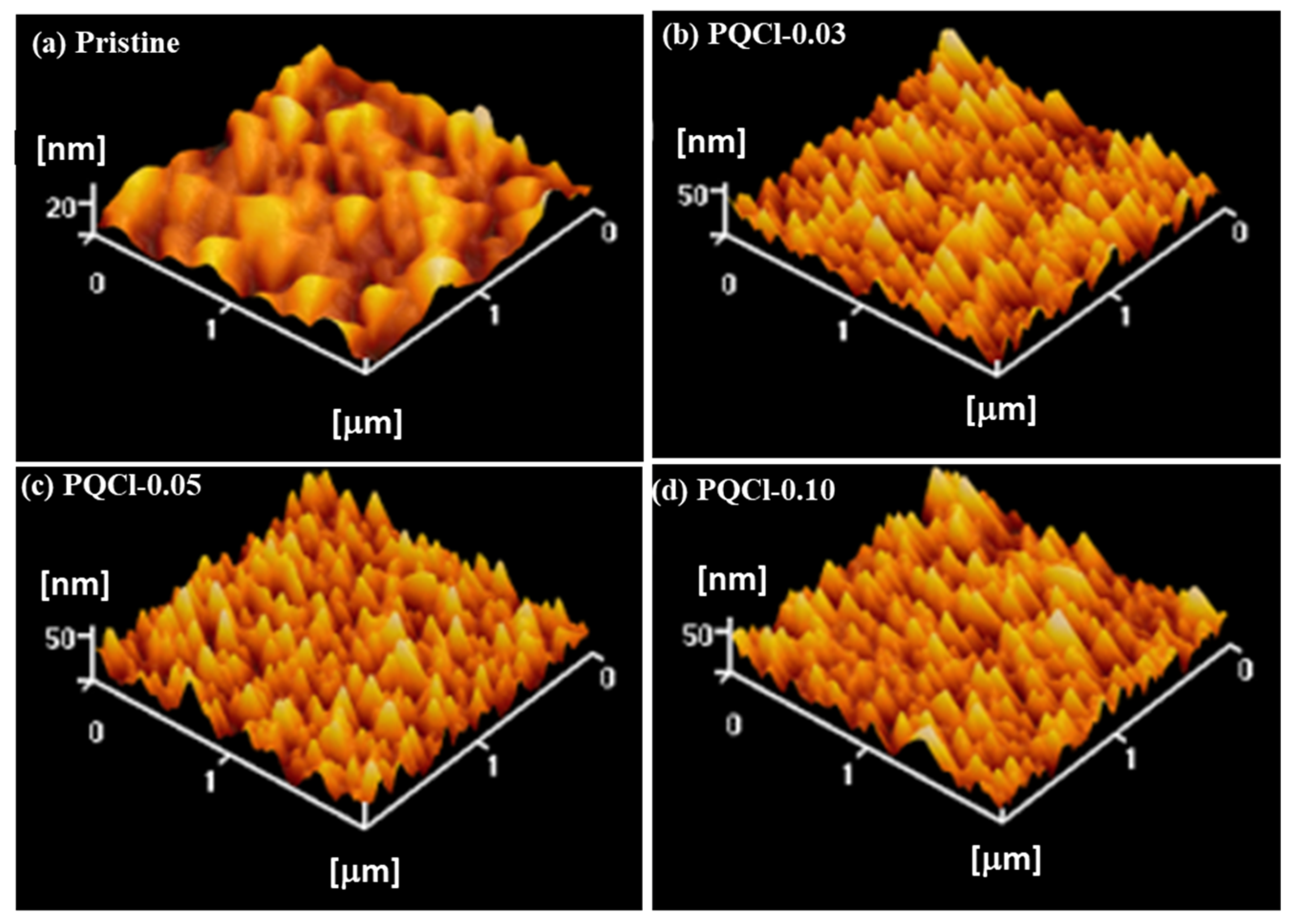
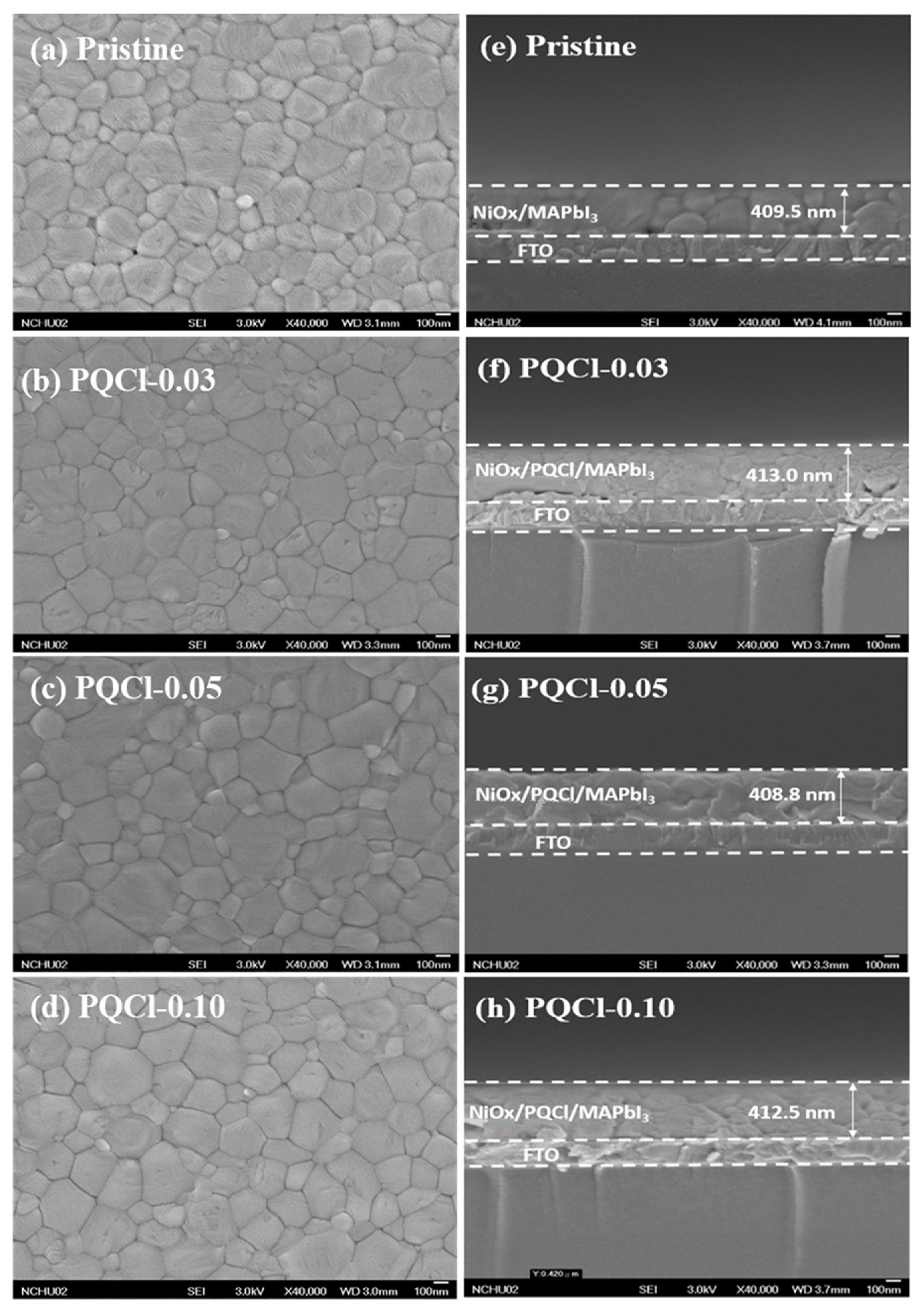

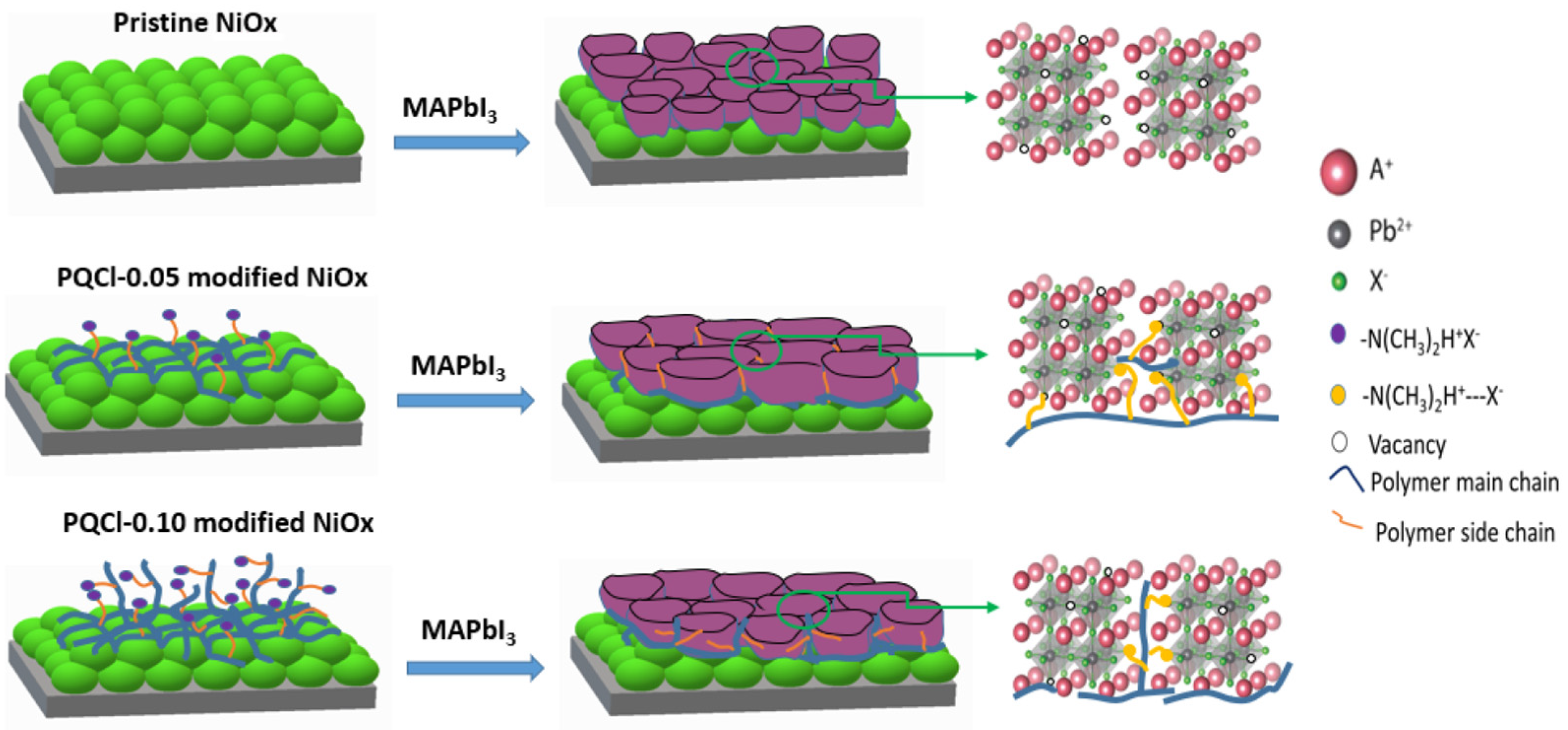
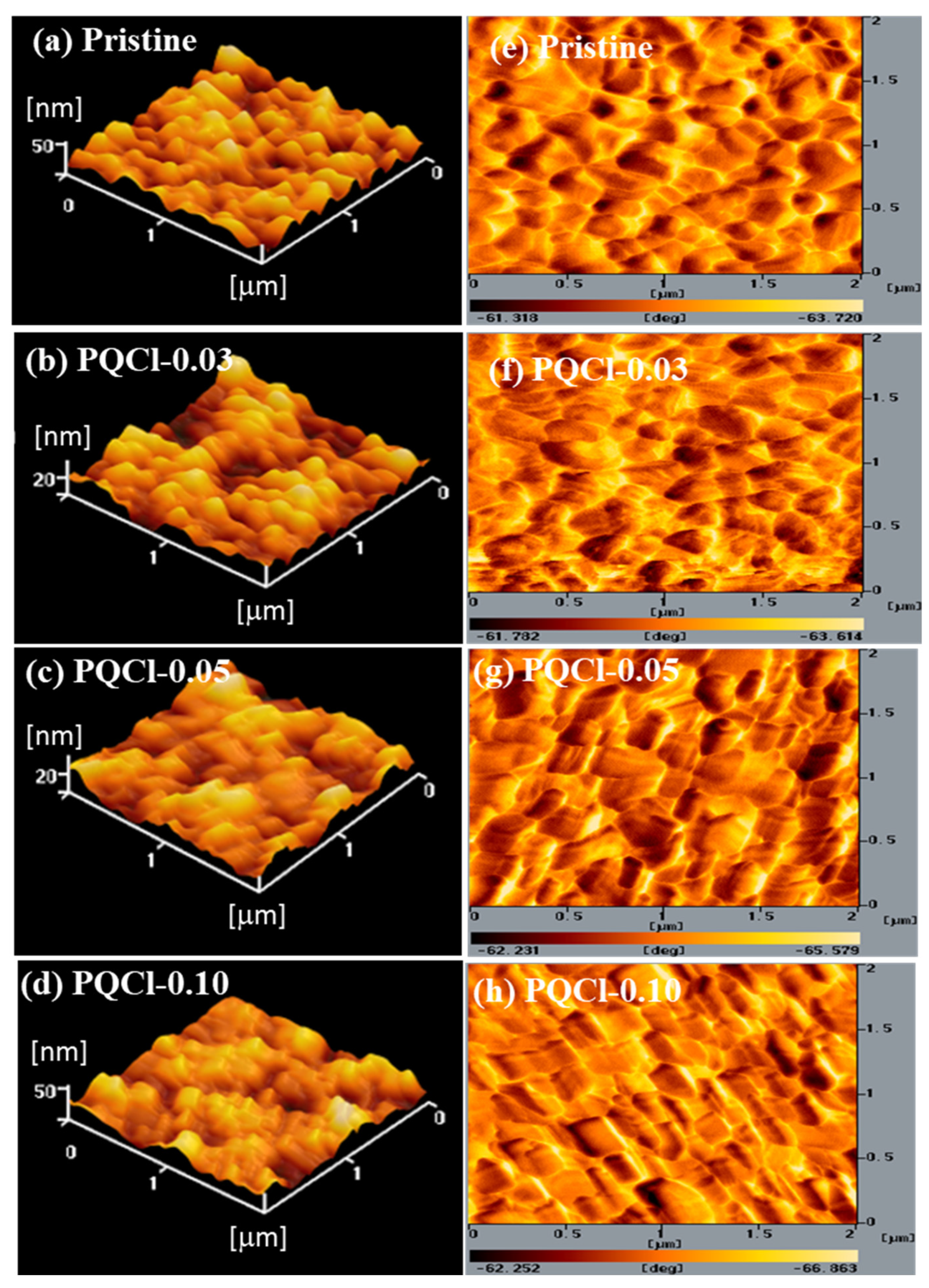
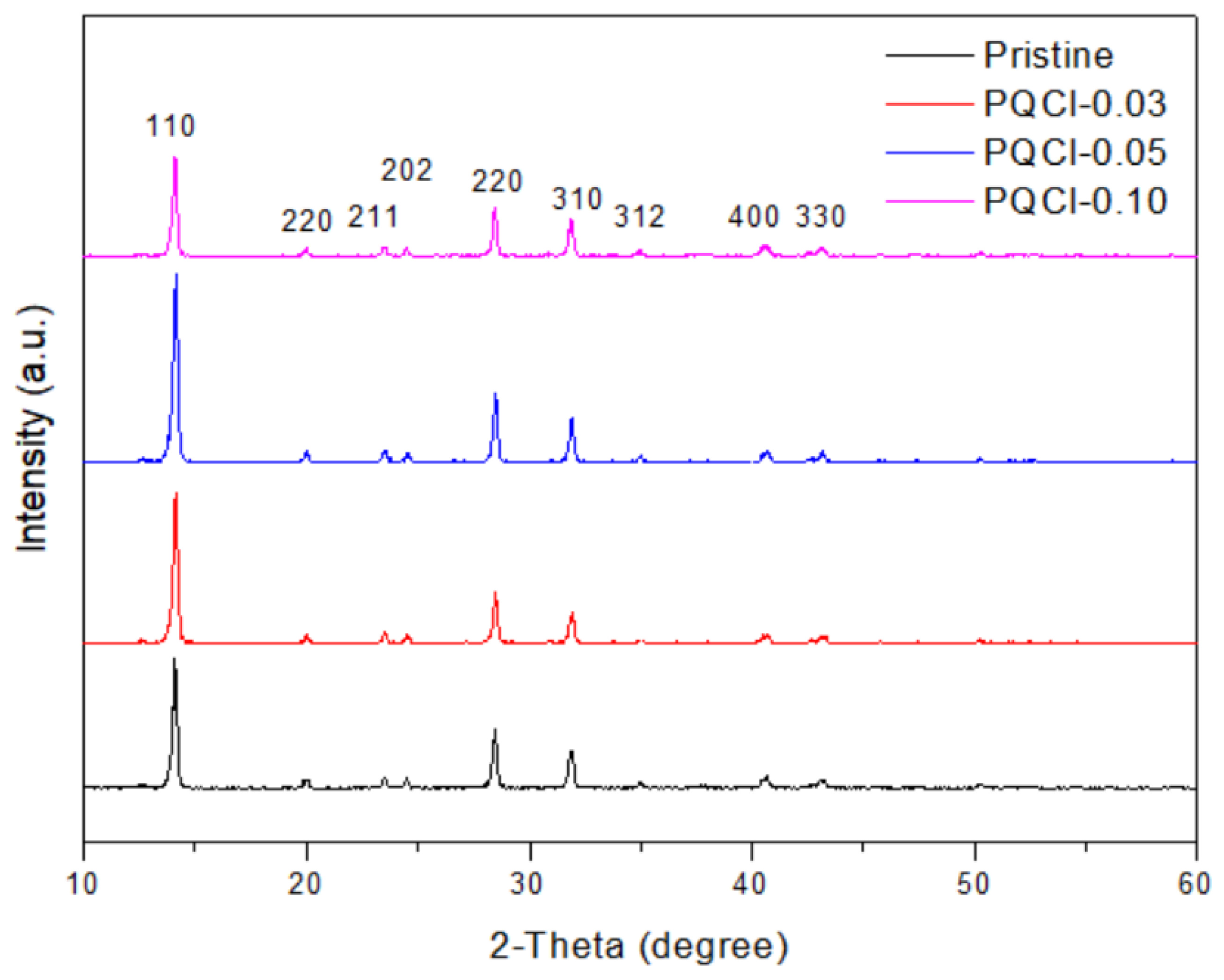
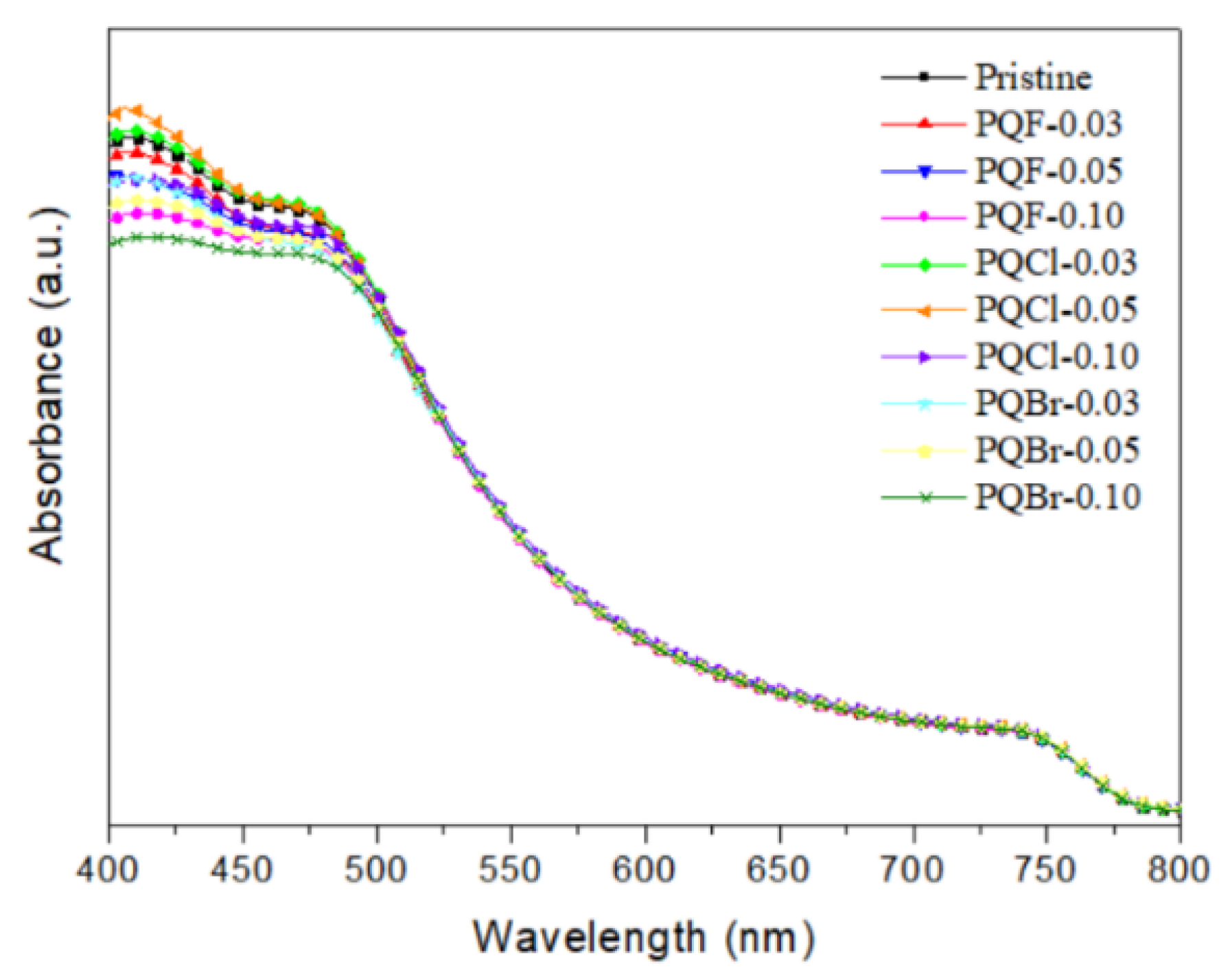
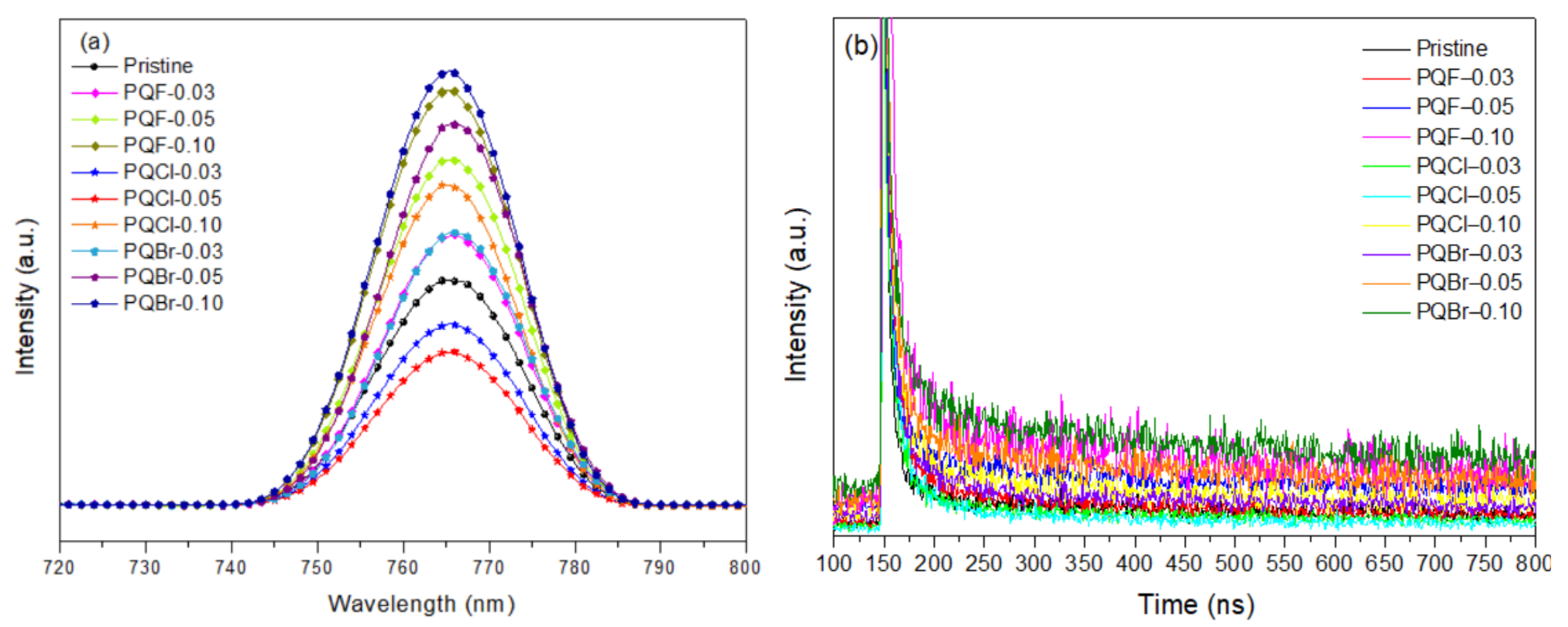
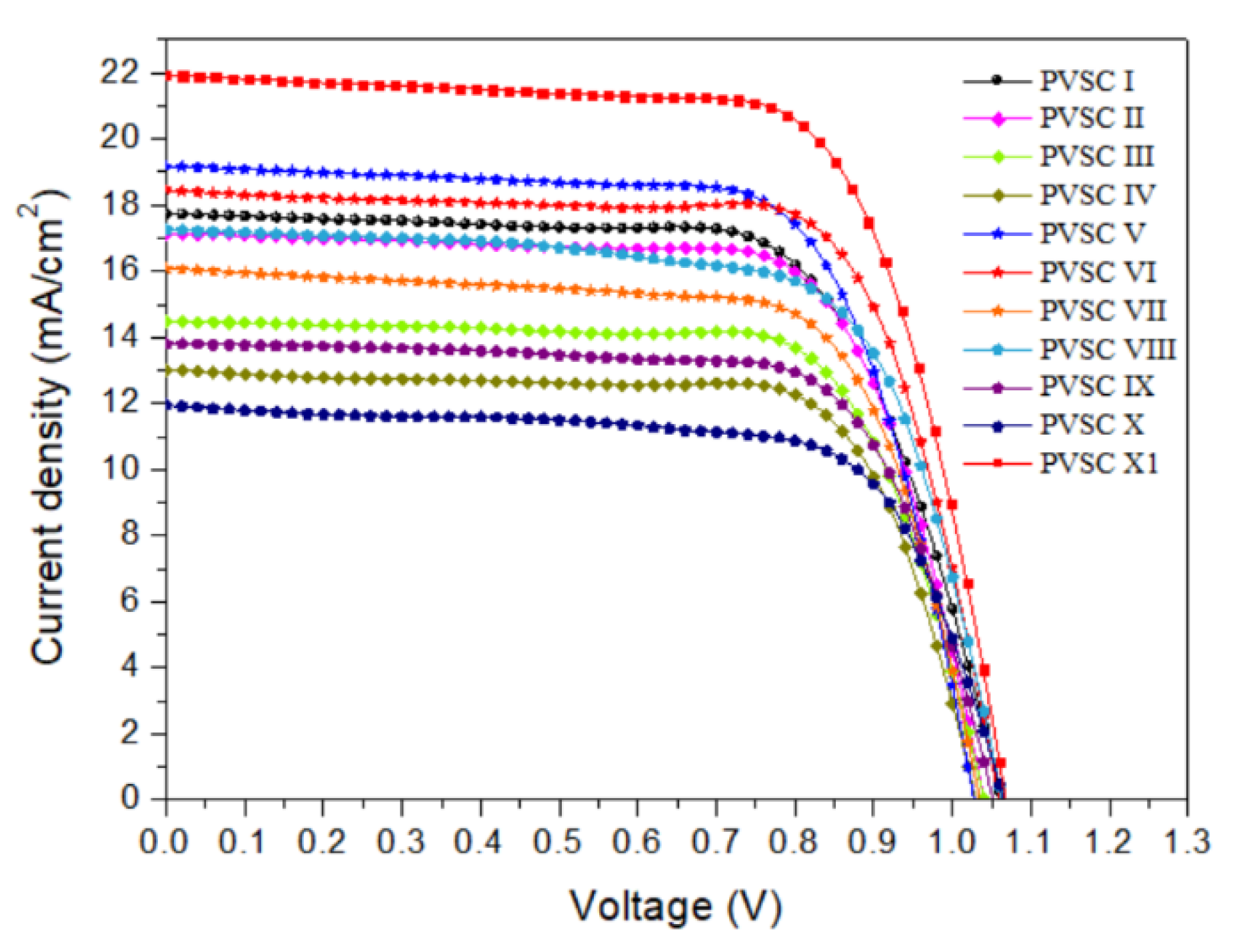
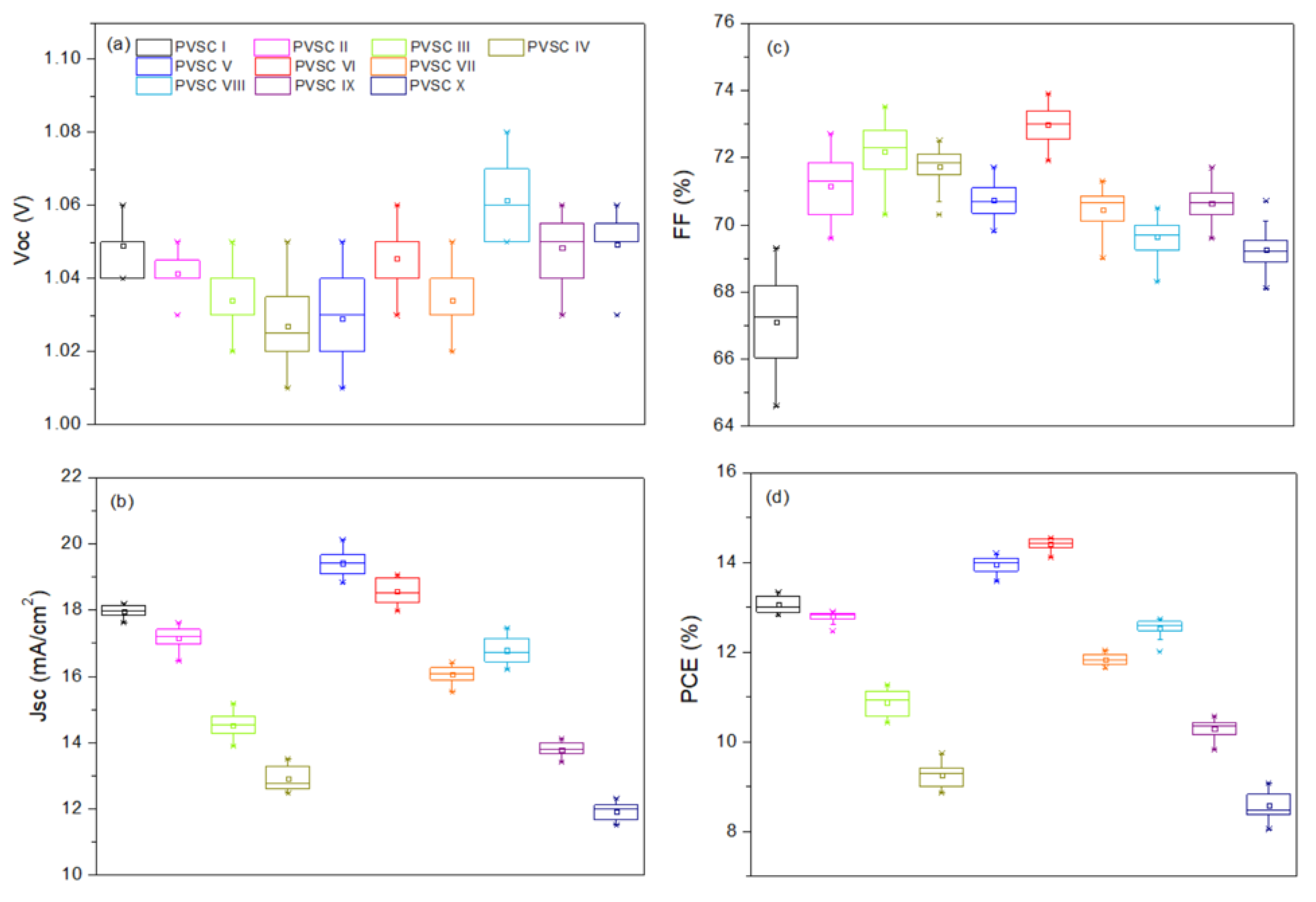
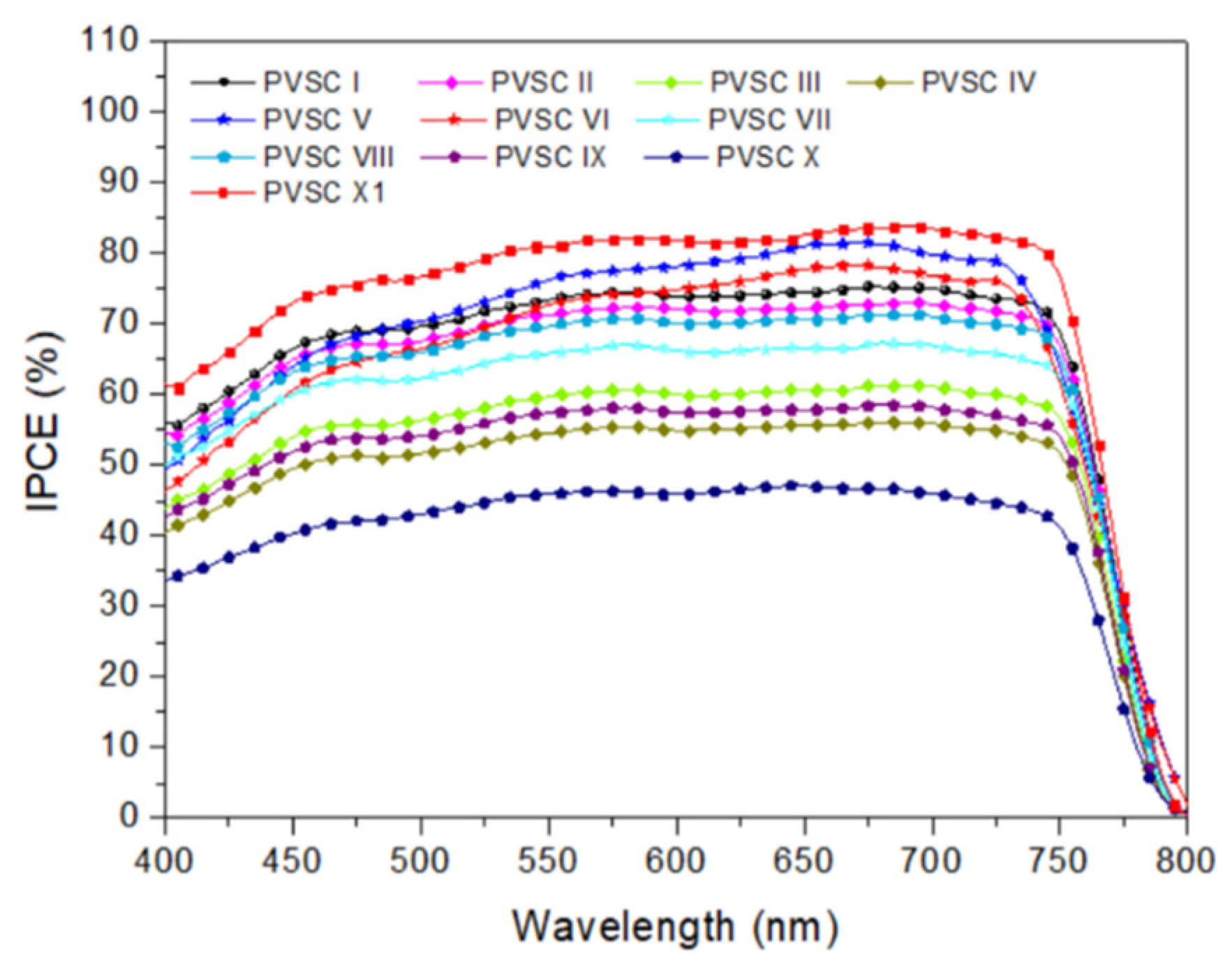
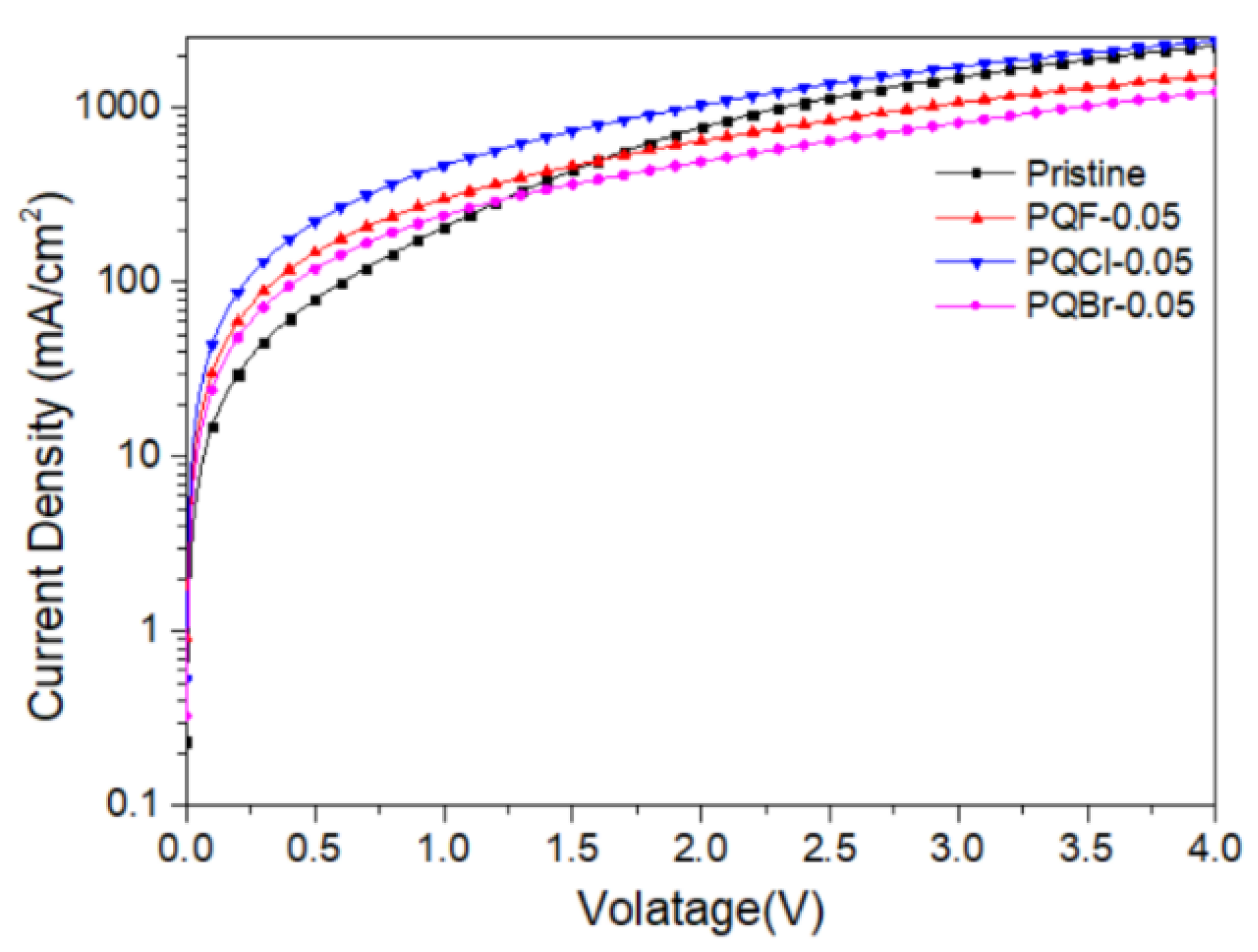
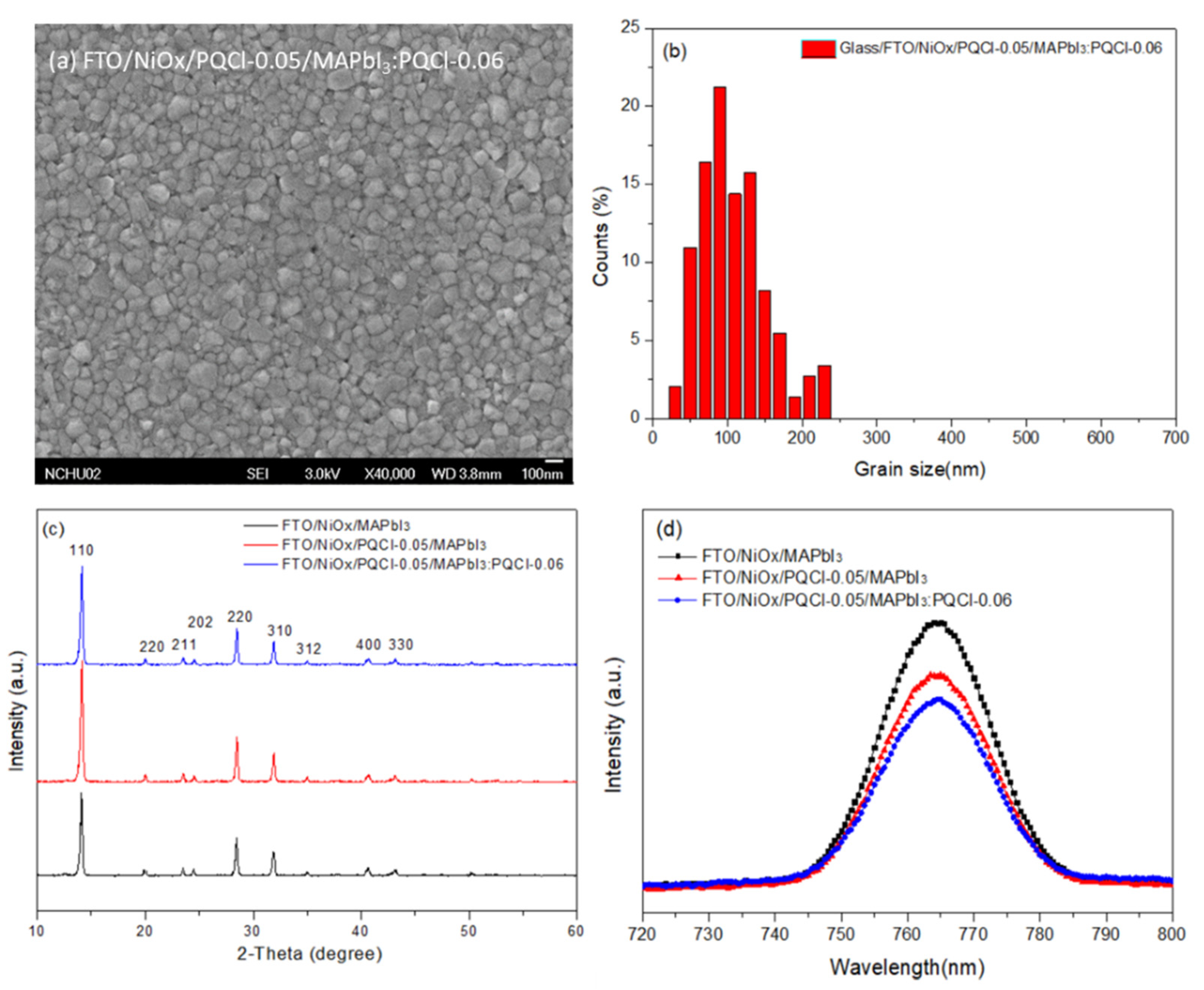
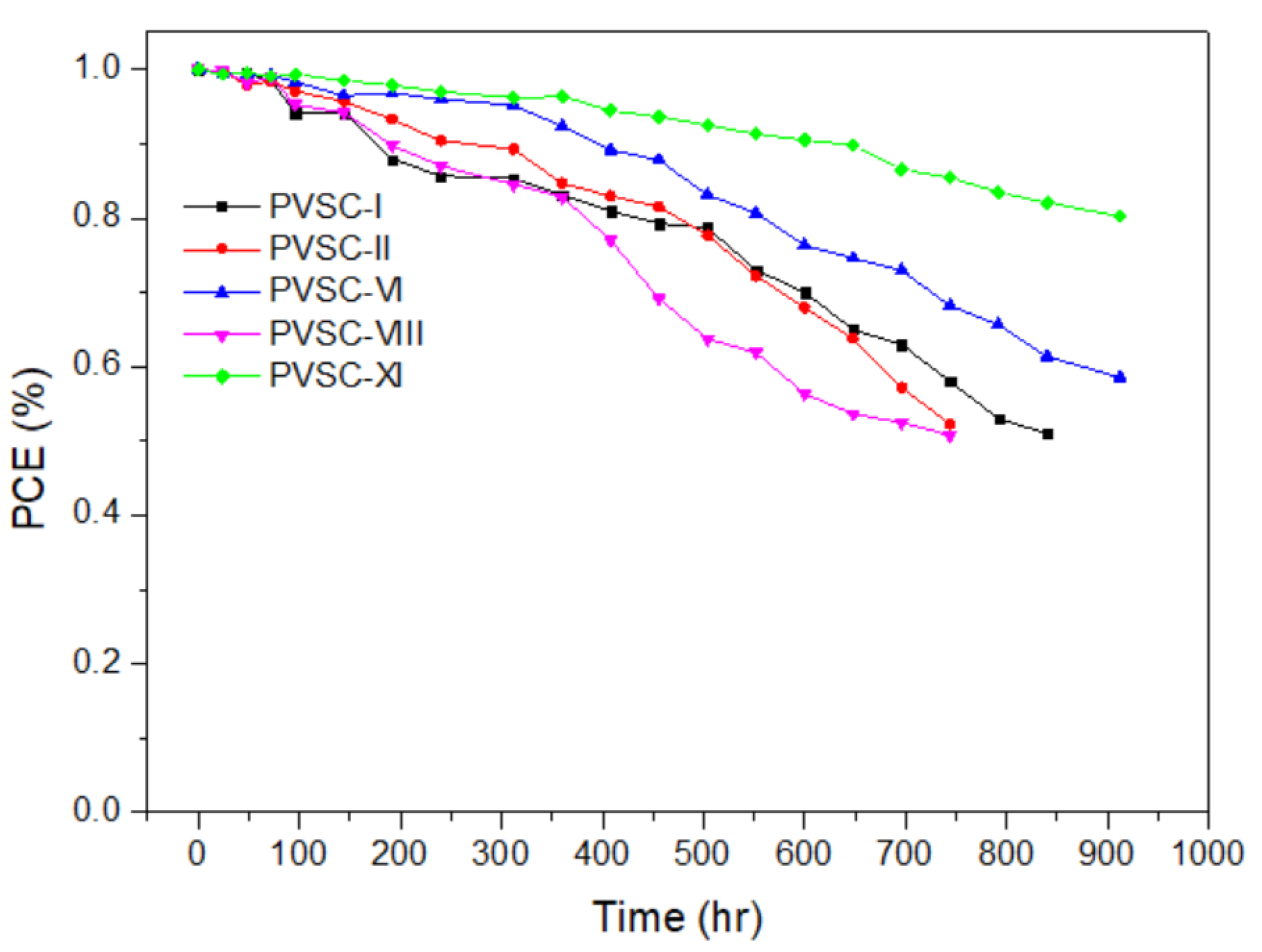
| HTL | RMS * (nm) | CA @ (°) | Average ψ Grain Size (nm) | RMS # (nm) | FWHM § (110) | Crystal Size Θ (nm) |
|---|---|---|---|---|---|---|
| NiOx | 6.31 ± 0.75 | 38.93 | 244.22 | 9.20 ± 0.43 | 0.219 | 36.17 |
| NiOx/PQF-0.03 | 10.01 ± 0.65 | 25.19 | 233.85 | 7.71 ± 0.25 | 0.220 | 36.01 |
| NiOx/PQF-0.05 | 9.13 ± 0.78 | 24.51 | 225.26 | 7.39 ± 0.37 | 0.225 | 35.23 |
| NiOx/PQF-0.10 | 11.26 ± 0.54 | 25.01 | 221.81 | 8.01 ± 0.36 | 0.227 | 34.91 |
| NiOx/PQCl-0.03 | 8.84 ± 0.48 | 23.89 | 256.95 | 7.39 ± 0.29 | 0.213 | 37.19 |
| NiOx/PQCl-0.05 | 9.41 ± 0.54 | 22.77 | 271.57 | 6.09 ± 0.24 | 0.210 | 37.72 |
| NiOx/PQCl-0.10 | 9.46 ± 0.66 | 24.01 | 241.41 | 7.15 ± 0.33 | 0.222 | 35.70 |
| NiOx/PQBr-0.03 | 9.99 ± 0.56 | 29.30 | 233.37 | 7.90 ± 0.37 | 0.226 | 35.07 |
| NiOx/PQBr-0.05 | 9.31 ± 0.65 | 31.46 | 241.52 | 7.43 ± 0.35 | 0.229 | 34.61 |
| NiOx/PQBr-0.10 | 9.96 ± 0.48 | 30.26 | 234.92 | 8.24 ± 0.41 | 0.233 | 34.00 |
| Perovskite Layer | A (%) | τ1 (ns) | B (%) | τ2 (ns) | τavg (ns) |
|---|---|---|---|---|---|
| MAPbI3 | 31.73 | 3.92 | 68.27 | 87.45 | 85.74 |
| PQF-0.03/MAPbI3 | 36.03 | 16.5 | 63.97 | 102.30 | 95.16 |
| PQF-0.05/MAPbI3 | 32.89 | 6.97 | 67.11 | 160.01 | 156.81 |
| PQF-0.10/MAPbI3 | 16.05 | 8.60 | 83.95 | 191.02 | 189.47 |
| PQCl-0.03/MAPbI3 | 19.82 | 3.27 | 44.48 | 80.18 | 78.81 |
| PQCl-0.05/MAPbI3 | 18.85 | 4.39 | 81.15 | 59.09 | 58.16 |
| PQCl-0.10/MAPbI3 | 18.25 | 4.60 | 81.75 | 120.32 | 119.34 |
| PQBr-0.03/MAPbI3 | 30.35 | 5.63 | 69.65 | 113.25 | 110.96 |
| PQBr-0.05/MAPbI3 | 19.30 | 8.21 | 80.70 | 171.30 | 170.67 |
| PQBr-0.10/MAPbI3 | 16.59 | 9.11 | 83.41 | 216.80 | 240.86 |
| PVSC | Interfacial Layer | VOC (V) | JSC (mA cm−2) | FF (%) | PCE (%) | Best PCE (%) |
|---|---|---|---|---|---|---|
| PVSC-Ⅰ | – | 1.05 ± 0.01 | 17.89 ± 0.26 | 67.2 ± 2.1 | 13.08 ± 0.25 | 13.33 |
| PVSC-Ⅱ | PQF-0.03 | 1.04 ± 0.01 | 17.08 ± 0.53 | 71.0 ± 1.3 | 12.68 ± 0.21 | 12.89 |
| PVSC-Ⅲ | PQF-0.05 | 1.04 ± 0.01 | 14.49 ± 0.61 | 71.9 ± 1.6 | 10.85 ± 0.42 | 11.27 |
| PVSC-Ⅳ | PQF-0.10 | 1.03 ± 0.01 | 12.98 ± 0.51 | 71.4 ± 1.1 | 9.31 ± 0.43 | 9.74 |
| PVSC-Ⅴ | PQCl-0.03 | 1.03 ± 0.01 | 19.64 ± 0.47 | 70.7 ± 0.9 | 13.89 ± 0.30 | 14.19 |
| PVSC-Ⅵ | PQCl-0.05 | 1.05 ± 0.01 | 18.51 ± 0.53 | 72.9 ± 1.1 | 14.20 ± 0.20 | 14.40 |
| PVSC-Ⅶ | PQCl-0.10 | 1.04 ± 0.01 | 15.95 ± 0.43 | 70.2 ± 1.1 | 11.84 ± 0.20 | 12.04 |
| PVSC-Ⅷ | PQBr-0.03 | 1.07 ± 0.01 | 16.83 ± 0.62 | 79.7 ± 0.8 | 12.38 ± 0.36 | 12.74 |
| PVSC-Ⅸ | PQBr-0.05 | 1.05 ± 0.01 | 13.75 ± 0.35 | 70.7 ± 1.0 | 10.20 ± 0.38 | 10.58 |
| PVSC-Ⅹ | PQBr-0.10 | 1.05 ± 0.01 | 11.88 ± 0.37 | 69.4 ± 1.3 | 8.57 ± 0.51 | 9.08 |
| PVSC-ⅩI * | PQCl-0.05 | 1.05 ± 0.01 | 21.61 ± 0.35 | 70.5 ± 0.6 | 16.0 ± 0.53 | 16.53 |
Disclaimer/Publisher’s Note: The statements, opinions and data contained in all publications are solely those of the individual author(s) and contributor(s) and not of MDPI and/or the editor(s). MDPI and/or the editor(s) disclaim responsibility for any injury to people or property resulting from any ideas, methods, instructions or products referred to in the content. |
© 2023 by the authors. Licensee MDPI, Basel, Switzerland. This article is an open access article distributed under the terms and conditions of the Creative Commons Attribution (CC BY) license (https://creativecommons.org/licenses/by/4.0/).
Share and Cite
Ho, I.-H.; Huang, Y.-J.; Cai, C.-E.; Liu, B.-T.; Wu, T.-M.; Lee, R.-H. Enhanced Photovoltaic Performance of Inverted Perovskite Solar Cells through Surface Modification of a NiOx-Based Hole-Transporting Layer with Quaternary Ammonium Halide–Containing Cellulose Derivatives. Polymers 2023, 15, 437. https://doi.org/10.3390/polym15020437
Ho I-H, Huang Y-J, Cai C-E, Liu B-T, Wu T-M, Lee R-H. Enhanced Photovoltaic Performance of Inverted Perovskite Solar Cells through Surface Modification of a NiOx-Based Hole-Transporting Layer with Quaternary Ammonium Halide–Containing Cellulose Derivatives. Polymers. 2023; 15(2):437. https://doi.org/10.3390/polym15020437
Chicago/Turabian StyleHo, I-Hsiu, Yi-Jou Huang, Cheng-En Cai, Bo-Tau Liu, Tzong-Ming Wu, and Rong-Ho Lee. 2023. "Enhanced Photovoltaic Performance of Inverted Perovskite Solar Cells through Surface Modification of a NiOx-Based Hole-Transporting Layer with Quaternary Ammonium Halide–Containing Cellulose Derivatives" Polymers 15, no. 2: 437. https://doi.org/10.3390/polym15020437
APA StyleHo, I.-H., Huang, Y.-J., Cai, C.-E., Liu, B.-T., Wu, T.-M., & Lee, R.-H. (2023). Enhanced Photovoltaic Performance of Inverted Perovskite Solar Cells through Surface Modification of a NiOx-Based Hole-Transporting Layer with Quaternary Ammonium Halide–Containing Cellulose Derivatives. Polymers, 15(2), 437. https://doi.org/10.3390/polym15020437








